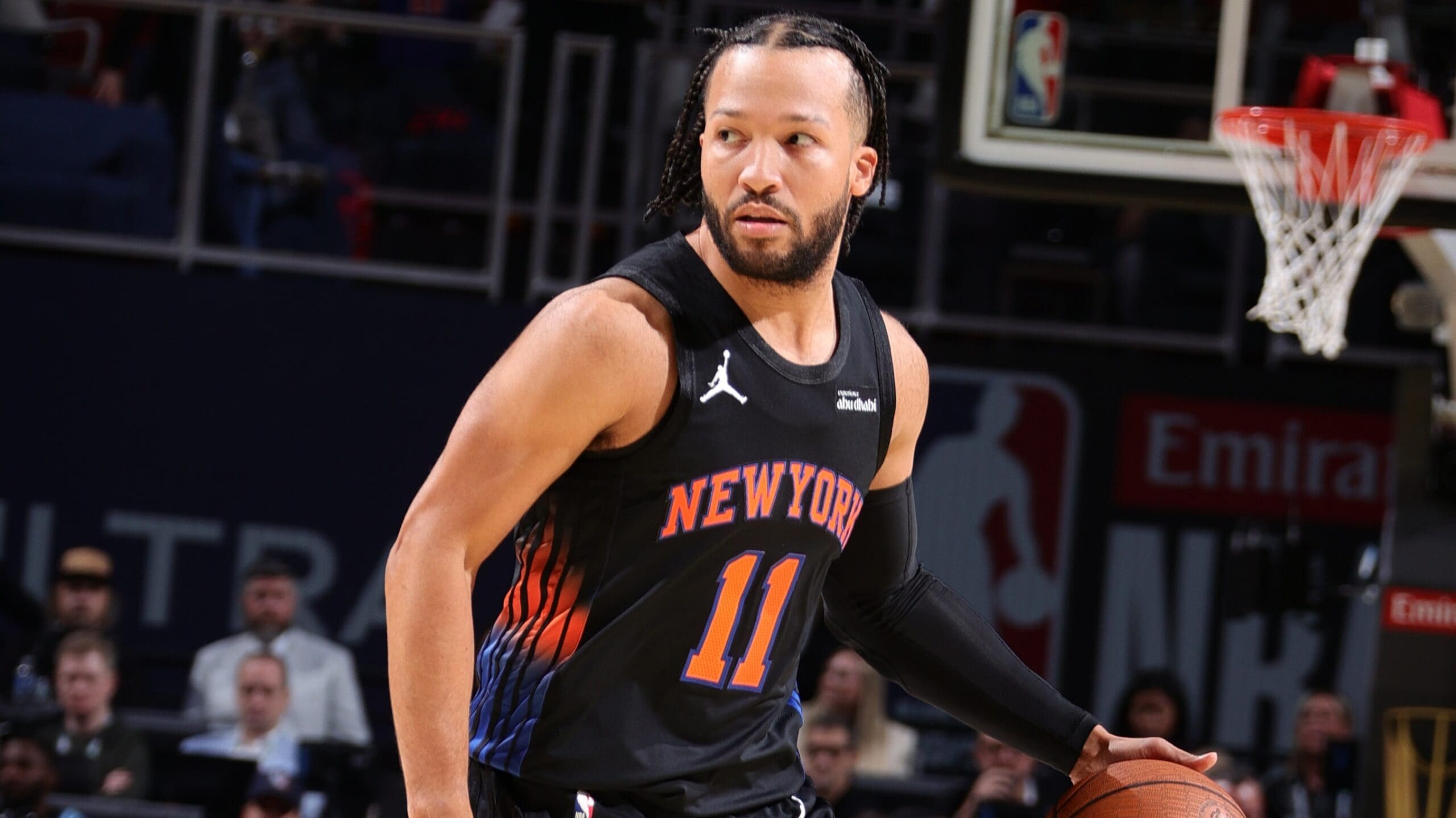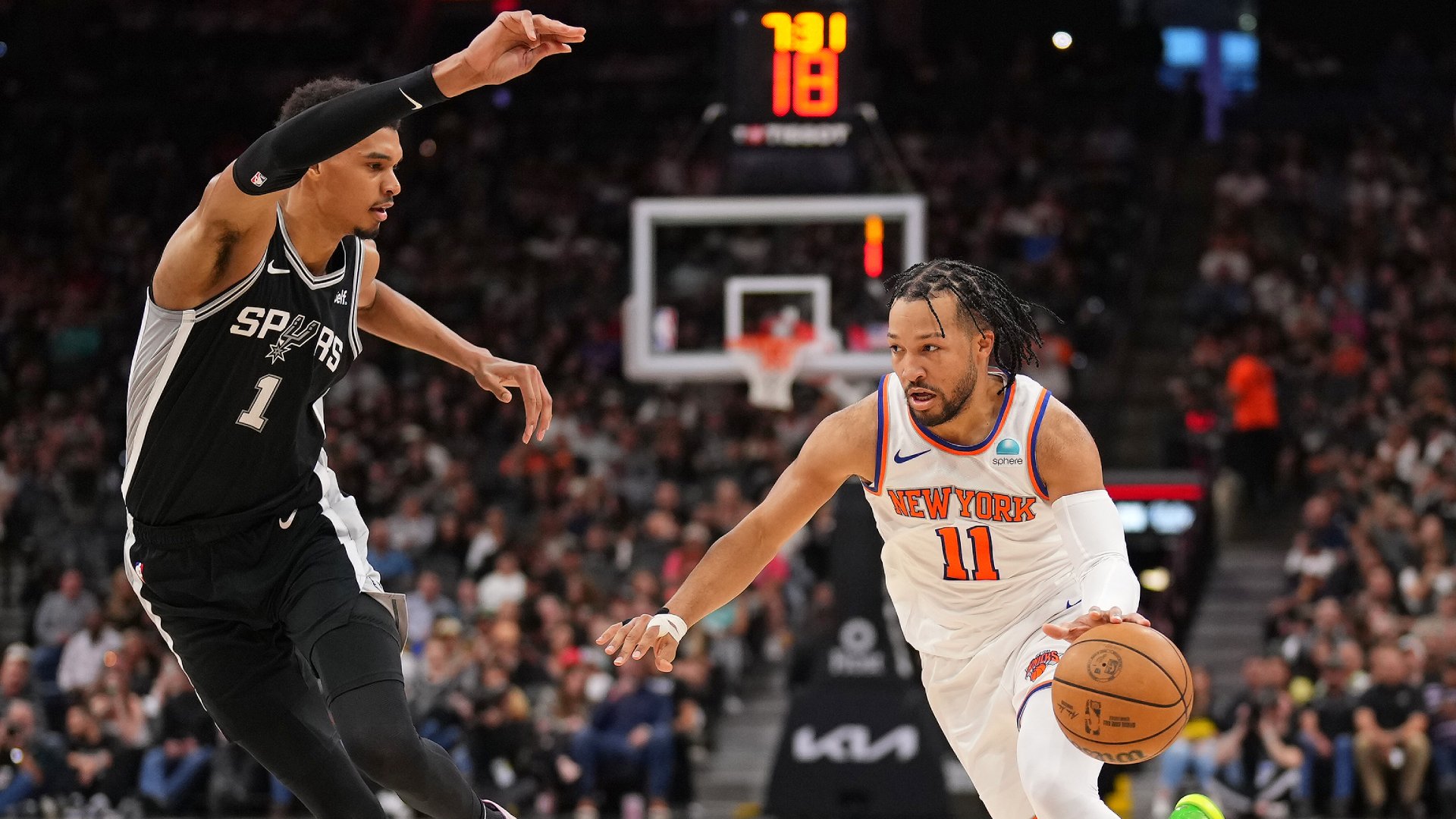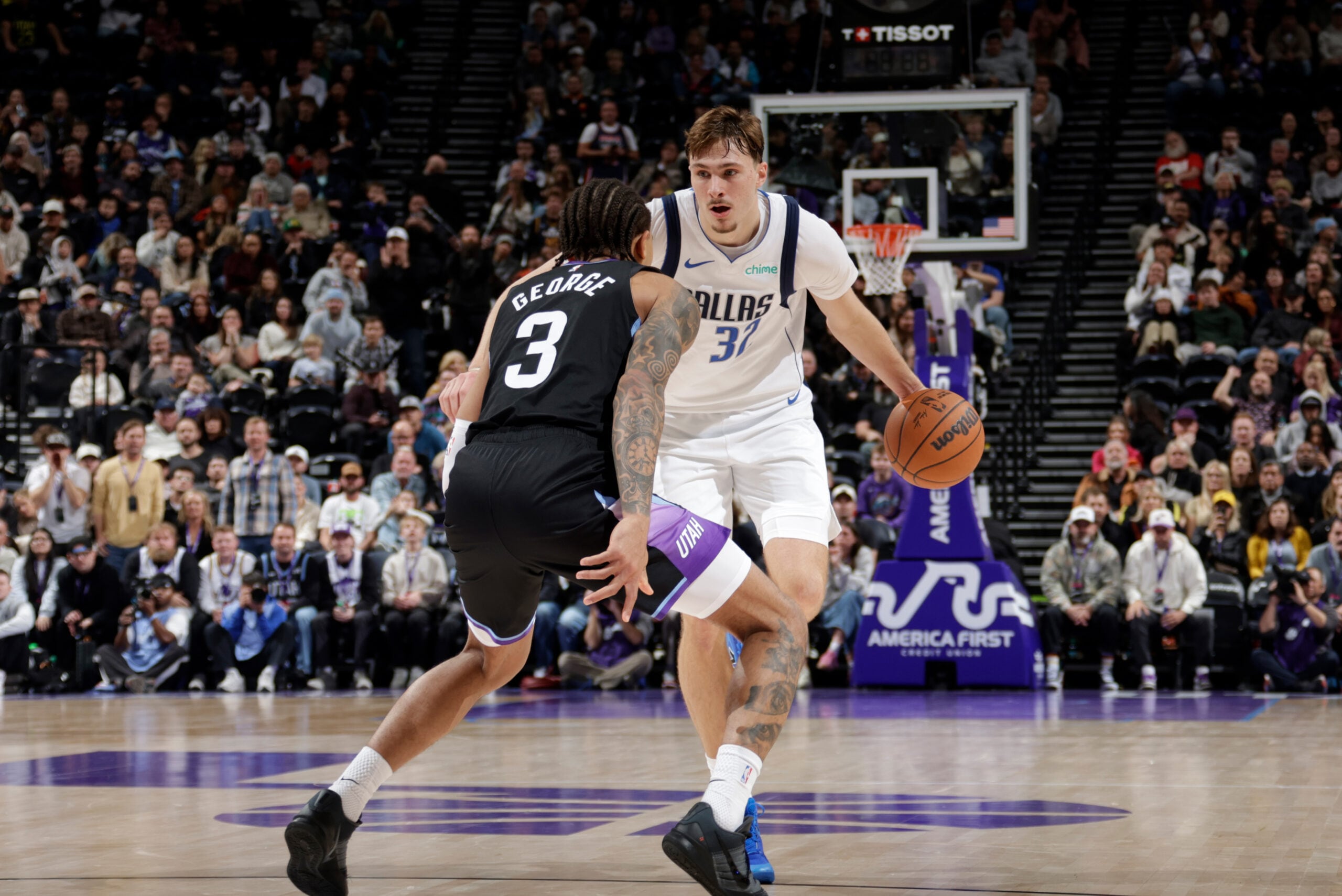
The Houston Rockets aren’t just unique on offense, where they isolate more than twice as much as any other team and lead the league in 3-point attempts for the fourth straight season.
The Rockets also defend unlike any other team, especially since they started playing without a center in late January. The Rockets switch screens (and even non-screens) more than any other team, often making their defensive possessions look a lot like their offensive possessions.
Some teams are loath to switch screens at all, hoping to avoid mismatches. Some teams will just switch with like-sized guards or wings. Others will switch 1-4, meaning that if there’s a screen not involving the guy that the center is guarding, they’ll switch it.
The Rockets don’t have a center, their two starting forwards — Robert Covington and P.J. Tucker — are capable of defending guards. Generally, they don’t fear mismatches where their own guards are left defending big men (knowing that post-ups aren’t very efficient). So they’re as liberal as it gets when it comes to switching. And that can make things rather simple for their defenders, limiting confusion on any given possession.
The primary goal of switching every screen is keeping the ball in front of the defender. When there’s another defender to meet the ball-handler on the other side of a screen, it’s more difficult for that ball-handler to get into the paint or create an advantage that leaves somebody open.
A switch-everything scheme can still be beat over the top. The Rockets are 22-1 when their opponents have shot 32% or worse from 3-point range and with 18-23 when their opponents have shot better than 32%. A switch-everything scheme can also be beat with talent. Good offense beats good defense.
But the Rockets have had some success against some of the league’s best offenses. When they’re locked in, they’re switching is sharp, they keep the ball in front of them, and they make you take tough shots.
When It Works Well …
The Rockets will have breakdowns on some switches (see here, here and here), where two defenders end up guarding the same player, leaving someone open. A switching scheme is also susceptible to screens being slipped, where the screener’s defender is ready to switch, but the other defender doesn’t feel the screen (and the need to switch) …
But generally, the Rockets’ switching is pretty clean. And every game, they’ll have some really impressive switching sequences.
Here are a few examples…
Play 1. Danuel House Jr. switches an early Marcus Smart-Jaylen Brown ball screen and then immediately switches a hand-off from Smart to Gordon Hayward. Hayward gets a ball screen from Daniel Theis and P.J. Tucker switches that. House, now guarding a fourth different player in the span of four seconds, is able to recover to Theis as Tucker pressures Hayward, making a pass to Theis more difficult. Hayward eventually backs out into an isolation, Tucker continues with the pressure, and rips the ball out of Hayward’s hands on his drive into the paint.
Number to know: The 0.82 points per possession the Rockets have allowed on isolations ranks fourth in the league.
Play 2. On a big possession in overtime, the Celtics try twice to catch the Rockets by slipping out of ball screens for Hayward. Eric Gordon doesn’t leave the ball on either one and Robert Covington stays attached to Jayson Tatum on the first slip. Tucker loses contact with Brown on the second, but is able to recover when Brown catches Hayward’s pass at the top of the 3-point arc. Tucker then forces Brown into an awkward pull-up jumper.
Number to know: The Rockets rank sixth in clutch defense, having allowed less than a point per possession with the score within five points in the last five minutes.
Play 3. The Rockets switch the second of two hand-offs on a weave, and then House switches a weak-side ball-screen for Ja Morant, keeping the ball on the perimeter. After a pair of non-penetrating passes, Morant attacks House off the dribble, drawing help from both Tucker and James Harden. De’Anthony Melton cuts behind Harden, but Russell Westbrook covers for Harden, Covington slides over to Westbrook’s man, and Morant has nowhere to go with the ball, throwing it away.
Number to know: Since his arrival, the Rockets have allowed 6.3 fewer points per 100 possessions with Covington on the floor (107.6) than with him on the floor (113.9).
Play 4. This is a quick one, where House and Covington both go toward Andrew Wiggins when Damion Lee slips out of a back-screen to the left corner. But Harden sees what’s happening and leaves Marquese Chriss on the block to close out on Lee. House, after realizing the initial mistake, slides over to box out Chriss.
Number to know: The Rockets rank 10th in opponent 3-point percentage (34.8%) and 17th in the (lowest) percentage of their opponents’ shots that have come from 3-point range (38.4%).
Play 5. Back to the Boston game, where the Rockets are up one with less than 20 seconds to go in overtime. Tatum gives up the ball, looking to get it back on a flare off a Theis screen. But Tucker stays attached to Tatum and denies the return pass. Westbrook switches a hand-off from Hayward to Brown and Covington switches a ball screen from Theis, preventing Brown from getting to the basket. Brown misses a step-back jumper and time expires.
Number to know: The Rockets have had the league’s best defense (101.4 points allowed per 100 possessions in two games) against the Celtics fifth-ranked offense.
Issues On The Break
Alas, as good as the Rockets can be at switching seamlessly, they still rank 16th defensively, having allowed 109.9 points per 100 possessions. Since going without a center on Jan. 31, they rank 12th defensively (111.0).
The Rockets’ issues begin in transition. League-wide effective field goal percentage is highest (60%) in the first six seconds of the shot clock, and no team has allowed their opponents to take a greater percentage of their shots in the first six seconds than the Rockets (17%) …
Play 1. After Harden misses a 3, he gambles in the backcourt, trying to intercept Rudy Gobert’s outlet pass. That doesn’t work, House doesn’t pick anybody up in transition, and Harden is late to arrive as Jordan Clarkson drains a 3-pointer on the other end of the floor.
Number to know: According to Synergy play-type tracking, 17.8% of the Rockets’ opponents’ possessions, the league’s second-highest rate, have been in transition.
Play 2. After Hayward contests another Harden 3, he leaks out. Harden, however, remains in the backcourt, looking to pick off another outlet pass that never comes. The result is an uncontested layup for Hayward.
Number to know: The Rockets are one of two teams — Atlanta is the other — who rank in the bottom 10 in opponent second-chance points, opponent fast break points, and opponent points in the paint per 100 possessions.
Play 3. After a dead ball, Melton blows by Austin Rivers and finishes over Jeff Green.
Number to know: The Rockets have allowed 3.5 more points per 100 possessions with Rivers on the floor (110.3) than they have with him off the floor (106.8). That’s their worst on-off DefRtg differential.
Play 4. When Ivica Zubac rebounds a wild save/shot from House, Westbrook and Kawhi Leonard are standing next to each other on the left wing. Five seconds later, Leonard is scoring on a layup and Westbrook has barely crossed midcourt.
Number to know: The Rockets have seen the league’s second biggest increase in pace, from 98.4 possessions per 48 minutes (27th) last season to 103.6 (fourth) this season.
Play 5. After Eric Gordon misses a 3, the rebound is batted out to Marcus Morris and Gordon actually takes a step backward. Leonard trails the break and drains a 3 before Gordon can get back.
Number to know: The Rockets have allowed 148 3-pointers in the first six seconds of the shot clock, tied (with Portland) for most in the league, according to Second Spectrum tracking.
Issues On The Ball
When the Rockets switch everything and their opponents can’t gain advantages via screens, the opponents’ possessions often look like those of the Rockets. According to Synergy play-type tracking, 7.9% of their opponent possessions, the league’s highest rate, have been isolations. Consider that stat just counts isolations that end in a shot, drawn foul or turnover from the ball-handler.
While defenses can keep the ball in front of them by switching screens, each defender must prevent dribble penetration. The Houston defense can often be broken down in one-on-one situations …
Play 1. The Rockets switch seamlessly (even executing a three-man switch on the left side of the floor) for the first 15 seconds of the shot clock. But on a late-clock isolation, Mike Conley gets by Thabo Sefolosha, draws help from House, and drops the ball off for Tony Bradley.
Number to know: The Rockets are one of five teams — along with the Hornets, Bulls, Cavs and Pistons — that rank in the bottom 10 in both opponent field goal percentage in the restricted area (65.9%, 26th) and the percentage of their opponents’ shots that have come in the restricted area (33.7%, 22nd).
Play 2. Again, the Rockets seamlessly execute a three-man switch, this time on the ball, with Harden picking up Morant, House sliding down to the rolling Gorgui Dieng, and Tucker switching out to Josh Jackson. Covington then switches a back-screen on Tucker and deflects the ball into the backcourt. But Morant picks it up and gets to the rim, when Harden gets caught reaching.
Number to know: The Rockets have been outscored 4.7 points in the paint per game. That’s the the league’s third-worst discrepancy, better than only those of the Wizards (-5.6) and Warriors (-5.0).
Play 3. The Rockets successfully switch a “Spain” or “stack” pick-and-roll, with Covington switching onto Zubac after a back-screen from Paul George. George then beats Tucker off the dribble, drawing help from Covington and gets Zubac a dunk.
Number to know: Tucker has defended 105 isolation possessions, second most in the league. The 0.87 points per possession he’s allowed on isolations ranks 12th among 20 players who have defended at least 75.
Play 4. Two switches put Harden on Marcus Smart, who breaks down the league’s leading scorer with a hesitation move, collapses the defense, and kicks the ball out for a Hayward corner 3-pointer.
Number to know: Twenty-seven percent of the Rockets’ opponents’ 3-point attempts have come from the corners. That’s the second-highest opponent rate, lower than only that of the Raptors (33%).
Play 5. Green is there in the paint when Jarrett Culver drives by Ben McLemore’s close-out. But Culver gets by Green with a spin move.
Number to know: Since they went to full-time small-ball (Jan. 31), the Rockets rank 22nd in opponent field goal percentage in the restricted area (66.7%) and 25th in the percentage of their opponents’ shots that have come in the restricted area (34.9%).
Issues Off The Ball
When the opponent is playing one-on-one, the defender on the ball isn’t the only one that has a job to do. If one of his teammates isn’t aware of both his man and the ball, things can break down …
Play 1. The Rockets stifle a Joe Ingles drive, but Westbrook is a hair late in reacting to Clarkson’s dive to the rim.
Number to know: The Rockets are 23-2 when they’ve scored more than 115 points per 100 possessions, with this Feb. 9 game to the Jazz (decided by a ridiculous shot at the buzzer) being one of the two losses.
Play 2. The Rockets successfully switch a few screens, but another weak-side dive (from Culver) catches Rivers off guard, and Westbrook can’t keep the rookie from finishing.
Number to know: According to Second Spectrum, 15.6% of the Rockets’ opponents’ shots have come in the last six seconds of the shot clock. That’s the seventh-highest opponent rate.
Play 3. When Julius Randle cuts behind a ball-watching Gordon, Tucker is there to pick him up. But then Maurice Harkless cuts behind Harden, who was digging toward Randle in the post.
Number to know: The Rockets have been the league’s slowest-moving team, averaging just 3.99 miles per hour.
And Issues On The glass
The biggest issue with playing small is being small … an issue can be exacerbated by the Rockets’ switching. It’s enough of a challenge for the 6-foot-5 Tucker to keep opposing seven-footers off the glass. When the Rockets’ not-so-beefy players switch onto opposing bigs, rebounding becomes even more difficult.
After they went to full-time small-ball, the Rockets ranked dead last in defensive rebounding percentage, grabbing just 68.3% of available defensive boards…
Play 1. Willy Hernangomez is initially being guarded by Tucker, but after a pair of switches, McLemore is tasked with handling Hernangomez under the basket as House forces a tough step-back from Miles Bridges at the end of the shot clock. Harden slides over to box out, but Hernangomez reaches over Harden and taps the ball out. He then sets a screen for Terry Rozier, who beats Harden off the dribble.
Number to know: The Rockets have been outrebounded in 16 of the 17 games they’ve played since they went to full-time small-ball. This loss in Charlotte was the one exception.
Play 2. After two switches, Westbrook is guarding Rudy Gobert in the paint. Covington bails him out, but Gobert still has the reach advantage on the rebound. The ball ends up in the hands of Donovan Mitchell, who drains a 3-pointer.
Number to know: This will be the fourth time in the last five seasons that the Rockets rank in the bottom 10 in defensive rebounding percentage, though they ranked fourth two seasons ago.
Play 3. A three-way switch leaves House trying to box out Zubac. He’s unsuccessful and Westbrook fouls Zubac on the rebound.
Number to know: The Rockets’ starting lineup — Harden, Westbrook, House, Covington and Tucker — has grabbed just 46.6% of available rebounds, the fourth-lowest rate among 50 lineups that have played at least 150 minutes together.
Play 4. The Rockets force a James Ennis pull-up 2 late in the clock, but switches have Rivers trying to keep Mo Bamba off the glass. He doesn’t do so well.
Number to know: Weirdly, the Rockets are one of six teams who have not allowed at least 25 second chance points in a game this season. Their opponent high is 24 (Lakers on Jan. 18).
Play 5. When Mitchell Robinson sets a ball screen for Kevin Knox, Green switches onto the ball and Gordon slides down to pick up the roll man, preventing a lob and seemingly rescuing McLemore from having to handle the seven-footer. Gordon isn’t big enough either and gets dunked on for his effort.
Number to know: In this March 2 game, the Knicks outrebounded the Rockets, 65-34. That’s tied for the biggest rebound differential in the league this season.
All Is Not Lost, Houston
The Rockets aren’t going to be taller when the season resumes. In fact, they’ll be shorter, having waived Isaiah Hartenstein, one of the two seven footers they had on the roster. Rebounding will continue to be an issue.
Many of their defensive breakdowns are fixable. Houston has shown that, when it is locked in, it can be pretty good on defense. While the Rockets rank 16th defensively overall, they have the eighth-best defense (110.0 points allowed per 100 possessions in 23 games) against the league’s top-10 offenses. They have the second-smallest difference between their winning percentage vs. the 17 teams under .500 (25-13, .658) and their winning percentage vs. the 13 teams with winning records (15-11, .577).
When the Warriors won their second straight championship with Kevin Durant two seasons ago, the Rockets took them to seven games in the conference finals … with defense. Those three Houston wins were three of Golden State’s six worst offensive games of that postseason, with Games 4 and 5 being the two worst. With how well and often they switched screens, the Rockets stifled the Warriors’ ball movement and forced tough shots.
Maybe there’s more of that kind of defense coming from the Rockets. Swapping Clint Capela for Covington not only gave them an extra shooter on offense, it gave them one of the most versatile defenders in the league, an ideal fit in their switch-everything scheme. Despite the rebounding issues, the Rockets’ have allowed just 101.8 points per 100 possessions in 238 total minutes with Harden, Westbrook, Covington and Tucker on the floor together. At the same time, they’ve scored much more efficiently in those minutes (111.1 per 100) than they did in 652 total minutes with the other three and Capela instead of Covington (104.1).
The Rockets’ defense isn’t going to be as good as their offense, which is now in its fourth straight season of ranking first or second in efficiency. But the defense just needs to be good enough for the Rockets to be a dangerous team in the Western Conference playoffs.
If the switching is sharp and their other issues can be minimized, the defense is capable of giving the Rockets a chance.
* * *
John Schuhmann is a senior stats analyst for NBA.com. You can e-mail him here, find his archive here and follow him on Twitter.
The views on this page do not necessarily reflect the views of the NBA, its clubs or Turner Broadcasting.










